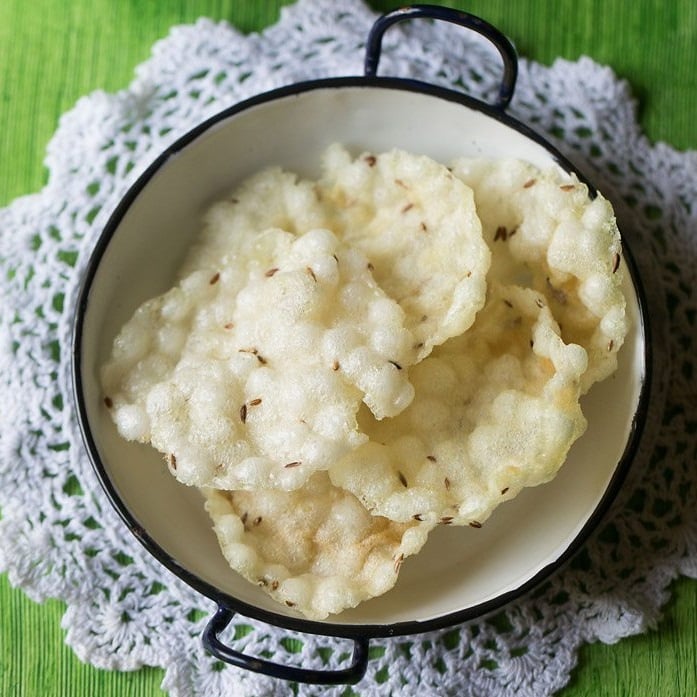Sabudana Papad
4.9
(8)
Your folders
Your folders
Prep Time: 180 minutes
Cook Time: 30 minutes
Total: 210 minutes
Servings: 640
Cost: $0.01 /serving
Author : Dassana Amit

Ingredients
Export 3 ingredients for grocery delivery
Instructions
Step 1
Using a strainer or colander, rinse sabudana in water once or twice. Then soak sabudana in 1.5 to 1.75 cups water.
Step 2
Soak for 2 to 3 hours or overnight.
Step 3
Later check a few sabudana by mashing them with your fingers. They should mash easily when you press them. If the center feels hard, then soak for some more time. If the pearls are softened well, then drain all the water. Keep aside.
Step 4
In a heavy pan or kadai take 4 cups water and add the sabudana.
Step 5
Add 2 teaspoons cumin seeds.
Step 6
For more taste of jeera, you can add 3 teaspoons cumin seeds also. For some heat and spice, you can also add green chilli paste or dry red chili paste or chopped green chilies. Some garlic paste or ginger paste can also be added.
Step 7
Add 1.5 teaspoon rock salt or as per taste. You can also use regular salt instead of rock salt.
Step 8
Mix everything and keep the kadai or pan on the stove top on a low to medium-low flame. Keep stirring at intervals.
Step 9
Do keep a check when the sabudana mixture is getting cooked.
Step 10
Slowly and gradually the mixture will start thickening. Do stir in between so that the sabudana pearls do not stick to the bottom of the pan or kadai.
Step 11
Meanwhile place a parchment paper or butter paper or a large tray or plate. You may need 3 to 4 trays or plate. You can also use a large sheet of plastic to spread the sabudana papads.
Step 12
When the sabudana pearls have softened, turned translucent and you see a porridge like consistency, then the mixture is done.
Step 13
Switch off the flame and add 1 teaspoon lemon juice. mix very well.
Step 14
Now take the papad mixture in a spoon. gently pour it on the butter paper.
Step 15
With the spoon itself lightly spread it.
Step 16
Do this with the entire mixture. You have to spread the papad mixture as soon as you switch off the flame. On cooling the mixture will thicken more and become lumpy making it difficult to make papads.
Step 17
Keep the sabudana papads to sun dry for 5 to 6 days. The number of days will depend on the intensity of sunlight received and the number of hours the papads are kept in direct sunlight.
Step 18
After 1 day, you can cover a thin cotton cloth on the sun drying papads to avoid dust from settling on them, especially if you stay in a place where there is a lot of dust in the air.
Step 19
During the night, get the trays or plates in your kitchen. Then the next day again you can keep them in the sunlight.
Step 20
After getting sun dried for 6 days, the sabudana papads will become crisp, brittle and will be dried completely.
Step 21
Store them in an air tight jar at room temperature.
Step 22
Heat some oil in a kadai. Do not use too much oil but just enough oil for the papads to be deep fried. Let the oil become hot and keep the flame on medium.
Step 23
Place papad in the hot oil.
Step 24
The papad will start to puff up as soon as you place it in the oil.
Step 25
With the help of tongs or a spatula press the papad on various sides when frying, so that it gets fried evenly. Be careful also as at times some oil also splutters when frying sabudana papads.
Step 26
When the papad is fried from one side, lift it with the tongs.
Step 27
Turn over and fry the second side.
Step 28
Lift with the tongs. Do not fry the sabudana papads till golden. They just need to be fried till they look crisp and white. A few golden specks here and there are fine.
Step 29
Place the fried papad on kitchen paper towels. This way fry all the papads. You can fry papads and place them in an airtight steel box if serving lunch or dinner after a few hours. In an air-tight box, these papads stay crisp for 1 to 2 days.
Step 30
Serve them with any indian meal.